Together in Prosperity: Tales from a Chinese county
chinadaily.com.cn | Updated: 2019-11-12 15:01

New Houses, New Ideas
It was especially sunny in Huichang during the last week of October.
At Zhangtang village, Qiu Mandi, 73, was sipping tea on a stool in the courtyard with her husband in front of their new three-story house. The tiled exterior gleamed under the sun, and Chen Cai's name was posted on their front gate. When Chen showed up that morning, the mother of four walked over and clutched his hands in welcome like he was one of her own sons.
The home of her youngest son was built in 2015, with a government subsidy of 15,000 yuan. Little trace remains of the mud house that it once was. But the son wasn't home, nor was the daughter-in-law. They worked in the city - he was a forklift driver, she a tailor - during most time of the year, in another province to the south. The old couple lived with their grandson, still a middle school pupil.
Qiu, the family matriarch, invited Chen to sit down and drink tea. Her husband, Zeng Jinhong, 81, gestured toward a square table with trays of peanuts and dried sweet potatoes. She was wearing a thick overcoat and a cloth headscarf. He had difficulties hearing and had to wear an aid in his right ear. Otherwise they looked youthful and full of vigour for their age.
Chen animatedly spoke with the couple in the local dialect, asking about their health and the school boy's studies. Local authorities were experimenting with a new charity program, providing one-yuan (14-cent) lunch for the seniors on the few days when they came out for the country fairs in town. It was still a pilot program, staffed by volunteers and funded largely by donations. Chen made sure the old couple knew about this program.
At Nantian village, first secretary Wang Zhen was inspecting the crayfish ponds, with tufts of water-weeds floating on the placid surface. All was quiet; there was no sign of the fabled crustaceans, who preferred to hide in the mud anyway. The village had never seen a project like this before Wang first introduced it in 2018 after significant deliberation.
The ponds - spreading here and there in the valley, 20 hectares in all - used to be paddy fields. By leasing them for commercial use, farmers could get an instant payment of 6,000 yuan per hectare each year, doubling what they could earn from rice plantations.
The location has a unique advantage for crayfish. The village is surrounded by mountains where spring water flows all year around, where crayfish like to leave - healthy, clean, water that appeals to consumers - and for the farmers, it's free.
To maximize output, Wang Zhen handpicked an investor from Fujian who specializes in high-density cultivation. In the middle of each pond was an air pump, to make sure the crayfishes have enough oxygen. The investor also had well-established refrigerated storage and distribution capabilities, which was also of vital importance given the village's remoteness and lack of marketing channels. Wang had to take all into consideration.
New Schools, New Hopes
For the time being, Wang Zhen lived at the Nantian village headquarters, a three-story building painted a loud yellow. His bedroom-office hybrid on the second floor was no larger than 100 square feet. An electric toothbrush sat on the nightstand along with a bottle of soy sauce. In his cabinet were books and documents, as well as bowls and cups, with two dumbbells politely tucked under a rattan chair. A pair of rain-shoes sat next to a DYI cloth wardrobe.
Chen Cai also lived at the village. He used to be a primary school teacher and the family lived at the county seat. When he first came to Zhantang in May 2015, he shared a dormitory with a colleague at the village headquarters for nearly half a year.
While both village first secretaries lived modestly, it was the exact opposite for the local schools. Villagers at both places had access to nearby primary and middle schools, eliminating the trouble of sending children to boarding schools at the county seat. The schools also provided heavily-subsided lunches for merely 100 yuan each semester, sparing the kids midday commuting.
There was a small library on the ground floor of the Nantian village headquarters. A random leaf through the racks offered a wide range of titles, from children's literature, study guides, farming references, legal education, and even needlework books. There were also four computers by the door, where a logbook registered all borrows and returns. There are 264 such rural libraries across Huichang county, according to a local newspaper. College students were invited as library tutors during summer recess, offering an unprecedented cultural oasis to the countryside kids.
A brand-new public preschool was put into use in September at Jiuzhou village. Seventy-three kids were accepted in the first semester, divided into three different age groups. The small group, with 18 kids aged three to four, were mimicking cats' meowing after a teacher during a recent visit. Their bedroom was two doors away on the same floor, connected via an inside passage. In the middle was a spotless toilet.
Outside on the playground, the middle and senior groups were practising a football dance on plastic mats led by four teachers, near the end of which a little girl misjudged the cue and threw her ball into the air before the go-ahead. Suddenly all the balls went airborne. A few villagers stood by the preschool fence, looking at the hilarity inside.
Right next door was the village's new primary school, the first in Huichang to offer a full six-grade village education. The main building had four floors and 17 classrooms, not all of which were in use as the school had just opened in February. The old school, a brick-and-wood structure about 400 metres away, sat dilapidated.
At the time, there were 152 students at the new school. Unsurprisingly, the first grade had the largest student group - over forty - as parents flocked to enroll here. "We have ample space to expand in the future," said Wang Hairong, the school principal and math teacher for 25 years.
Wang, 45, was teaching a fifth grade class in preparation for the upcoming midterm exam. Outside on the school playground, the sixth grade's 11 pupils were practising football. The grass was real and the running tracks had soft, spongy surfaces. Though there was no match that afternoon, girls took possession of one side of the court and the boys stayed to the other, each group playing among themselves.
























